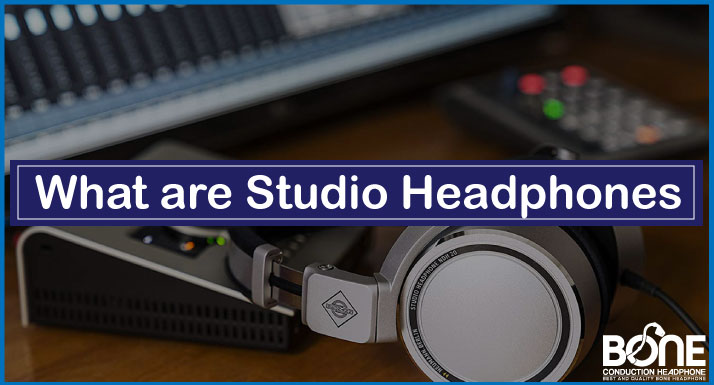The most straightforward answer to “What are Studio Headphones?” will be those headphones you wear in the studios for recording and monitoring the natural and detailed sound quality. The studio headphones’ flat frequency response, effective noise attenuation, and high volume handling show the true audio quality of the music. Studio headphones are specifically designed to deal with the studio routine for a more transparent and clear sound.
The studio headphones are solidly built and provide excellent comfort. Studio Headphone sales have been increasing in critical listening and the mixing industry. As a result, studio headphones are expected to reach a market value of 2093.8 Million USD by 2026.
In this piece of writing, we will discuss the mechanism of headphones and how it is different from regular headphones. Later in this article, we will tell you how DJ headphones differ from professional studio headphones. So, keep reading.
Why do studio headphones sound different?

In mixing studios, you need to hear very clearly every bit of the sound to bring out the best sound quality. There will be noise in your finished mix if you don’t hear the tiny nicks. For this reason, several aspects intrigue the audio experts to look for the studio headphones, including:
Noise Isolation & Noise Cancellation

As an audio engineer, you need to focus on the minute details when recording music. But, if your headphones do not come with noise isolation or cancellation, there is a chance of sound distortion or sound leakage. It will bring a disastrous experience, so the headphones should have the Noise Isolation feature to cope with such issues.
Sonic Neutrality
When you describe the word neutral, you will understand sonic neutrality. Neutral means no gain and no loss, remaining in the original state. The same is the sonic neutrality that your headphones should enable you to listen to the unchanged and unaltered voice. In a word, studio headphones bring the exact audio signals to the ear of the audio mixer.
What are the types of Studio Headphones?
When you look at the mechanism of the recording studio headphones, then you will know that the audio signals move then the diaphragm moves forward and backward. It leads sound to both sides, one to your ear and the same amount to the backward. There are three types of headphones to deal with that backside sound.
Closed Studio Headphones

When you place the covering on the backside of the earphone, that prevents the leakage of audio signals from the headphones, this type is called the close headphones. Any open mic or people around you will not be able to hear a bit from your headphones, but those extra audio signals can cause degradation of the original sound.
Open Studio Headphones

When the diaphragm moves back and forth, the sound moves to the ear and another side. When no cover is placed over the headphones or no padding is used to control the sound, these headphones are known as open headphones.
Semi-Open Studio Headphones

Semi-open studio headphones bring the equilibrium between open and closed ones. They come in semi-covered and semi-opened to exhibit balance that allows some sound to drain and air to pass through them. Sound engineers prefer semi-open headphones to deal with the leaking and distortion issue most of the time.
What is the difference between studio and regular headphones?
Both regular and Studio headphones have their uses and significance. It solely depends upon the needs and requirements of the consumer.
Regular Headphones

Regular headphones are usually made to deal with specific frequencies for the listeners. Music lovers have a better listening experience when using headphones. Different driver units help you get the complete frequency response to listening to better audio quality.
Nowadays, regular headphones also use noise-canceling technology for sound clarity, but still, they can get that detailed clarity as they are not comprised of much range. Wireless and wired headphones are both available for everyday use.
Key Aspects:
- Listening Music
- Browsing your favorite shows and movies.
- Calling
- Bluetooth
- Batteried and Mic
Studio Headphones

Studio headphones properly recreate sounds over the whole human hearing range, and it brings more clarity than the mixer or production needs. The audio engineers use this to produce detailed sound quality. The central aspect is the sound isolation it brings makes you isolated from the surrounding atmosphere to listen to every frequency more explicitly.
Bluetooth options ease wire tangling, but mainly wired studio headphones are used to avoid sound latency while using Studio headphones wireless.
Key Aspects:
- Audio engineers used to produce music.
- Monitoring and Recording
- Personal use/ Calling
- Batteried
- Built-in microphone/ Without Mic
What is the difference between studio and DJ headphones?

The main difference between studio and DJ headphones is the Sound Isolation and cancellation. When it comes to loudness and voice clarity, the DJ requires a headphone bringing more noise cancellation and can bear the high pressure like some headphones that cleared the US Military Standard Shock test.
On the other hand, studio headphones mix, monitor, and bring high-resolution sound. This headphone provides exceptional clarity over a wide frequency range and deep and accurate bass response, making it excellent for audio professionals.
You can read our guides for:
- How to Choose Studio Headphones
- Are Studio Headphones good for Mixing
- Why Are My Beats So Quiet
- Are Beats Good for Recording Music
Final Thoughts – Are Studio headphones necessary?
Yes, studio headphones are necessary while mixing, recording, and monitoring the music. It has become an imperative part of audio engineering, and if you are a novice, you better get the best studio headphones to have a clear insight into your music.

